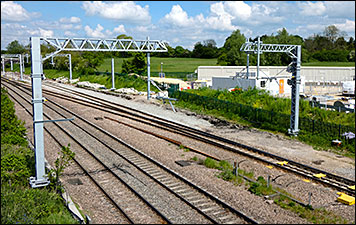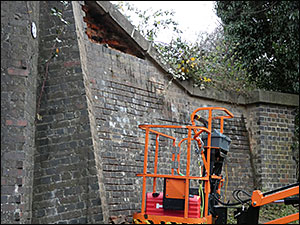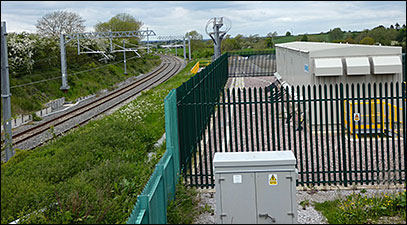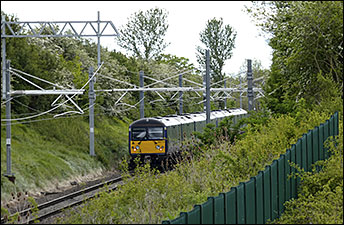Article by Paul Wright, 2021
As part of the Midland mainline upgrade, this would mean that both the goods (slow line) and passenger lines through Wymington will be served by "electrified" trains in the future. The power is delivered via wires that are suspended above the tracks by masts that are that are placed in regular intervals, and are 5 metres tall, these hold the overhead lines needed to electrify the route from Bedford to the North of Kettering.
This meant continuing the electrification from Bedford, this work made steady progress through the summer of 2018, and by mid June the work had reached the Sharnbrook area.
Work to electrify the Midland mainline was well underway, and this meant raised bridge replacements being put in to place in numerous rail locations, including Abbot's bridges previously in Wymington.
The highly visible orange army working for Network rail had made a start on erecting "overhead lines masts" between Corby and Kettering earlier in 2018.
By the end of the Summer 2018, the masts were in place in readiness for the rigging of the cables, this would be possible when the new road bridges at Irchester and Finedon road, Wellingborough, were completed.
This work had been over a six month period, in which the bridge had been closed between Irchester and Rushden, causing numerous headaches for motorists and shoppers on both sides of the bridge.
At least some motoring misery was relieved on Friday October 12th, as the Finedon road bridge in Wellingborough, which was finally opened in the afternoon, on a very windy, but mild sunny day.
The technology that will eventually be running through Wymington is not without teething problems, and on Tuesday 16th October 2018 a test train running from London to Bristol wrecked the cables that supply the power.
It was caused by a Hitachi 802 locomotive that snagged over 1,6000 feet of cable with its pantograph at Hanwell in west London.
Could we expect to suffer problems with the overhead cables during bad weather conditions? On the plus side these planned expensive Hitachi 802's can run on electric, or switch over to diesel power, they are certainly not cheap at £16 million per train.
These promised engines seem to be a long way off, and I was told that it may be 2022 at the earliest, before they come to us?
At Irchester, the road had been closed for an eight month period, which seemed like an eternity, but did open to road traffic a week earlier than planned, so all was flowing along the B569 in and out of the village again.
The fourth rail tracked section was re-instated through 2018 to allow normal working's of traffic, this had been taken out during the late 1980's.
That period was known as the "Leicester gap" which was the closing and removal of the Midland style mechanical signal boxes.
 |
|
Points equipment at Sharnbrook.
|
Then the signalling was done from the power boxes at West Hampstead, and the final part at Leicester, thus the so called “Leicester gap” was filled.
Long before all of this, Wymington did have its own little signal box on the "goods" line (the “up line”); it was located just to the top of South Grove as you were walking towards the Sharnbrook/Wymington tunnel.
It had five signals to control and was on the left hand side of the track near to the bridge. This was manned for most of the time by Mr Walt White who lived up near the old police house in Rushden Road in the village.
We did have another signalman living in Wymington, his name was Eric Lickerish, and he used to cycle to and from his shifts at Sharnbrook box, from his house in South Grove.
Several men from the village worked on track maintenance gangs, making sure that safety and repair work was kept on top of.
Three such names were “Sam Phillips, Royston (Pud) Ford, and Len (Slick) Hart.” They would work on the track, usually between Irchester and Sharnbrook, walking the “length” and tapping to make sure that things were okay. But at weekends would join a bigger assembled workforce to work in other areas.
Looking North from Abbott’s first bridge towards Irchester in one of our shots, you can see the work to bring back the second track bed, and the laying of the base for the power supply equipment. Secondly, completed work, and power masts and supply equipment installed. These are both on the goods/slow line on the deviation. Further interesting reading about why the deviation was needed can be found on Rushden Heritage by Peter Butler. When we were kids we used to play down the ‘Ballasole’, a shortened name derived from Ballast Hole, and would have been excavated when the line was being built. Sand from here was probably used for the cement being used on the bridges and tunnel.
 |
|
Repairing the bridge near New Inn.
|
On to the roads, and Podington Road in Wymington was closed from Monday, November 19th to Sunday, November 25th, 2018, as work to upgrade the rail bridge was being carried out.
This is the bridge nearest to the New Inn public house. The elements had changed too, with a cold blast from the East giving the workforce some nippy temperatures of around 4C.
The bridge was being strengthened ready for a second railway track to be installed on the bridge at a later date. This can is evident in our photo, showing decay in the brickwork etc.
On reflection, this bridge was always used as a two way running option, and used to carry very heavy steam engines pulling coal trains from the midlands and the north to London etc.
Growing up in South Grove from the early 1950's, I could see and hear the coal trains running up and down all day and night from my bedroom window, and would enjoy watching the oil lamps on the brake van at night coming in to view for a few brief moments.
All of this work was part of the Midland Main Line Upgrade, which would see the line electrified from London to Kettering and Corby via Bedford. The Midland Main Line Upgrade was one of the biggest investments in the railway since the Victorian era and should bring benefits for the millions of people who use it every year.
Over the Christmas period of 2018 a major project to upgrade the track layout north of Wellingborough station took place. Between the last service on Christmas Eve and the first service the 27th December, engineers worked around the clock to install five sets of switches and crossings – the equipment that allows trains to move from one piece track to another – as part of this Midland Main Line Upgrade project.
Under existing plans for the improvement of the route, electrification would extend north from London but stop at Kettering.
Well, that was the plan until March, 2019, when the Department for Transport (DFT) confirmed to Neil O’Brien, MP for Harborough, that it will be extending electrification from Kettering up to Market Harborough as part of their £1.5 billion Midland Mainline programme. Construction should be completed by autumn 2022.
The power for this stretch will be provided by picking up a power feed in the village of "Braybrooke" between Desborough and Market Harborough.
The Rail franchise had changed to Dutch owned company Abellio East Midlands from August, 2019, taking over from East Midlands Trains, the company owned by "Stagecoach".
By mid April, 2019, and the work had began to fix the overhead cables for the electrification, pushing north from Bedford, they had reached just past Oakley.
Loads of work being done over most weekends, and six sets of points were being installed up at Sharnbrook over the weekend of May 12th 2019.
This would allow six trains per hour in future, instead of the usual five. Putting in the fourth track, (quadrupling) is being done at about 50 yards per time too.
Up at Sharnbrook they have installed two electrical supply feeds, one is for the engine power, the other is for the track signalling equipment.
 |
|
Double tracks, and power supply.
|
Wymington has one of these power supply units sited near Abbotts first bridge. Over a long period, this area has been used as a plant compound to house various vans and heavy machinery.
Meanwhile over at Bedford, the Bromham road bridge was closed from Summer 2019. through to Spring 2020, due to bridge replacement work.
The Liberal democrat Mayor of Bedford, Mr Dave Hodgson, thought the disruption was an unfortunate pain for Bedford motorists, which did seem a bit self centred.
It was not all plain sailing during the early part of August, 2019, when strong winds brought down over head wires, with East Midlands trains and Thameslink both being badly affected.
By Autumn, the shiny copper coloured over head wires were in place on the fast and slow lines.
But the road bridge on the West bound section on the A45 towards Wellingbrough would open one month later than planned. This was to be in November, and was blamed on wet and windy weather conditions!
During the upgrade to the Midland Main Line meant the railways between Market Harborough and Bedford, and Corby to Bedford were closed on the weekends of November 2 and 3 and November 16 and 17.
During that first weekend, the bridge in Bromham Road, Bedford was being removed. This was the last road bridge to be demolished in the electrification of the Midland main line.
The electric fleet running between Corby and London was meant to be in place by December 2020, but that did not happen on schedule, due to Covid 19 health issues in the UK.
The spring of 2021 saw the introduction of a new timetable, Wellingborough would see the most changes with EMR acknowledging in the consultation saying "we understand these changes are significant".
Wellingborough station will only be served by the new EMR Electric trains that will provide trains to and from London every 30 minutes throughout the day, with all southbound services calling at Bedford, Luton, Luton Airport Parkway and London St Pancras International and all northbound calling at Kettering and Corby.
"The EMR Electrics will provide fast, cleaner, greener, comfortable journeys and offering more seats.” Unfortunately, it doesn't look like they had time to refurbish all of them before they went into service in May.
Kettering will become an interchange for passengers wanting to change to local services to complete their journeys.
Timetable changes will:
• Nearly double the number of services to and from London St Pancras International.
• Two services per hour to Nottingham.
• Quicker journey times to London St Pancras International on EMR Intercity services.
• First train arrives into London approximately 20 minutes earlier than previously.
• Last train leaves London at a similar time as before.
In the meantime, the new timetable was introduced on Sunday 16th May 2021. This saw EMR Connect services operating between Corby and London. Part of the £1.5 billion upgrade, was to provide more seats from Wellingborough, but some services are dropping in numbers, from 13 rains per hour to 8, especially in the mornings.
Up at Kettering four sidings have been built for electric trains, which will run between London and Corby from May 2021. The sidings will be a place where the electric trains can be kept overnight and cleaned, ready for passengers the next day.
The final Inter City 125 made it’s last run to St Pancras on Saturday 15th May, 2021. It was sporting the “The Last HST to London” headboard. The engine numbered 43102 and has gone to the National Railway Museum in York.
So, after 40 years the familiar sight and sounds of the Inter City 1-2-5 (HST), have now vanished from this neck of the woods.
When it was first introduced – the Intercity 1-2-5 signalled a new era for high-speed rail services, a power car which broke the world speed record in November 1987 was called “The Journey Shrinker”, she reached 148.5mph between Northallerton and York, on a test run.
 |
|
EMR Electric going towards "Bank Top" and Bedford.
|
As train spotters, we used to admire the Midland Pullman coming through Wymington twice a day, on its way to London in the morning, and back to Manchester in the afternoon. That all first class service was launched in the summer of 1960. Of course no young lad was ever without their Ian Allan train spotting book; they are still available on Amazon for about £9.00.
Talking of spotting trains, we can see a EMR electric going towards “Bank top” on its way to London through Wymington.
And in Mid May 2021, Rail passengers were promised a better and more efficient service under the biggest shake-up in decades.
A new state-owned body, Great British Railways (GBR), will set timetables and prices, sell tickets in England and manage rail infrastructure. |